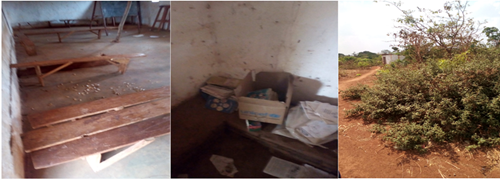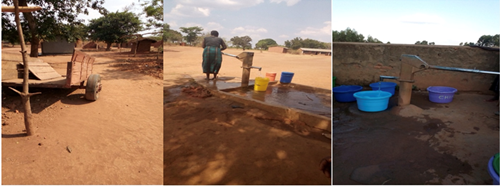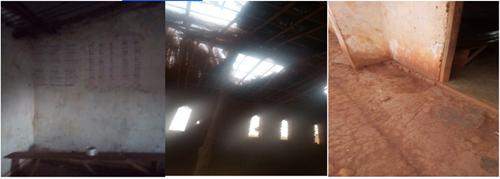Blog
Centring the voices of girls with disabilities: A Photovoice exploration of school life and challenges
Global focus on the educational needs and experiences of girls with disabilities has increased over the last few years. Since 2012, the Girls Education Challenge (GEC) has been supporting the most marginalised girls, including girls with disabilities through 41 projects that incorporate a variety of interventions. Previous evaluations of GEC have shown how girls with disabilities in 11 of its projects had a high rate of return to schools after COVID-19 and that the use of a twin-track approach in project interventions is more likely to be effective and good value for money.
A recent evaluation study used participatory methods to understand how educational interventions of GEC projects had impacted the lives of girls with disabilities and their families. In this blog, we engage with what girls with varied disabilities valued about secondary schooling and the challenges they faced. Using data gathered through Photovoice in Malawi, we forefront how 10 to 19-year-old girls with disabilities, enrolled in secondary schools, perceived and narrated their schooling experiences. Data were collected in two districts: Mchinji and Dedza, where the TEAM GIRL Malawi project is being run by Link Education International.
Country-based research teams engaged with 24 girls with disabilities and their families using semi-structured interviews and focus group discussions. With a subset of eight girls, additional in-depth data was collected using participatory methods of Photovoice and audio prompts. Here we present data from six girls who participated in the Photovoice activity.
The girls were given a series of open prompts and were provided with digital cameras to capture photographs in response to these prompts. The girls were trained to use the devices, and ethical issues such as consent and not invading others’ privacy were discussed at length. After the photographs had been collected, follow-up interviews were conducted with the girls to understand their motivations and reasons for taking these pictures. They were also encouraged to title each picture, and these titles have been retained in this write-up (pseudonyms have been used for their names).
Prompt 1: What do I like about my school?
“It is important to go to school so that I should have a better future.” (Chawezi, Mchinji).
An overarching response from all the girls was how being at school presented hope for a brighter future: “I couldn’t see a good future when I dropped out of school. At least it’s better now that I am back to school.” (Asante, Dedza).
They noted how schooling helps them acquire skills that will foster their ability to earn in the future. For instance, the photo of the car below was taken by a girl to emphasise the importance of education and the subsequent ability to earn money, “The importance of the picture is that we should work so that we can buy a car.” (Chawezi, Mchinji).
The Future (Chermaine, Dedza), The Bright Future (Chermaine, Dedza), Good Mobility (Chawezi, Mchinji)

To secure this future, the girls emphasised the importance of access to schools, both within schools and on the way to schools. Five of them stressed the significance of basic resources helping them in their ability to study, such as:
- Blackboards: “I chose to take a picture of this blackboard because I learned how to write using this blackboard.” (Dedza, Chermaine)
- Chairs: “My learning centre is good because we have chairs in my class.” (Akuzike, Mchinji)
- Books: “If you have books, you know how to read fast.” (Akuzike, Mchinji)”
- Functioning toilets: “It is a good school because it has a toilet.” (Alinafe, Mchinji).

Three of the girls presented pictures to show how well-functioning roads, as well as trees providing shade on the road, supported them in their access to schools. For instance, one girl expressed how she felt good looking at the picture of the road since, “the road is good because we walk on it when going to school.” (Alinafe, Mchinji).
The Road (Alinafe, Mchinji), The Beautiful Road (Chifundo, Dedza), Trees are Important (Chawezi, Mchinji)

Four girls also emphasised the importance of having basic nourishment, such as food and water, to be able to attend school. Chawezi presented a picture of an oxcart to demonstrate how, "the oxcart transports food which I take to have energy in order to come to school.” (Mchinji).
Oxcart (Chawezi, Mchinji), Importance of Water (Akuzike, Dedza), The School Borehole (Asante, Dedza)

Finally, three pictures demonstrated the importance of relationships that supported them in their ability to attend school. The first picture titled “my son”, highlighted that Chifundo values her son because he “accepts to stay at home with my parents whilst I go to school”. Second, “the wise woman”, is of the mother “who supports me to go to school.” Finally, “my beloved friend” captures the importance of a peer who, in Chawezi’s words,“helps me to take care of my baby so that I should have a chance to write my assignments and homework.”
My Son (Chifundo, Dedza), The Wise Woman (Chermaine, Dedza), My Beloved Friend (Chawezi, Mchinji)

Prompt 2: What do I find challenging about my school?
Two overarching challenges depicted by the girls concerned issues related to: (1) the community and (2) the significant lack of resources in schools.
Four pictures depicted how the sheer lack of resources, for instance in the form of proper lighting in the classrooms and infrastructure such as doors, impacted the girls’ ability to learn. For instance, one girl expressed how, “the whole roof is damaged, and we usually get wet in class. The lessons are disturbed." (Asante, Dedza). Similarly, lack of chairs and desks posed a problem since, “having no desks in class is a big problem because sitting down on the floor is a problem. It makes us uncomfortable and cause back aches in some of the learners.” (Asante, Dedza).
Reading, (Chawezi, Mchinji), The Roof at my School (Asante, Dedza), Door (Alinafe, Mchinji)

Of particular concern to the girls was poor hygienic conditions of school toilets. “People fail to take care of the toilet. People urinate anywhere in the toilet.” (Alinafe, Mchinji)
This was even more problematic when girls were menstruating. “We normally miss classes every month because the school fails to provide us with some basic needs for menstrual hygiene management.” (Asante, Dedza)
Hygiene (Akuzike, Dedza), Dirty Toilets (Alinafe, Mchinji), The Damaged Latrine (Chifundo, Dedza)

Finally, three of the girls expressed how issues concerning the community, such as lack of acceptance from community members, as well as conditions of the village, hampered their ability to go to school. For instance, when presenting a picture of girls in the village (“Nothing”), Asante stated, “These are girls from my village; they were laughing at me when I had my baby and for me to go to school.” (Dedza).
Alinafe, when speaking about safety in reaching school, expressed discomfort over the “mad man who sits near the road and chases me whenever I am coming to school. This makes me fail to attend to school.” (Mchinji). (Note: This incident was reported to the study team during fieldwork and necessary safeguarding and child protection measures were taken in response. The picture taken is not included due to issues of confidentiality and anonymity).
Lastly, Chinfundo highlighted how poverty affected her ability to attend school “My education and future are affected with the situation in this village. I constantly miss classes in search of food.” (Dedza)
Nothing (Asante, Dedza), The Poor Village (Chifundo, Dedza)
(Note: The original pictures have been edited so that the faces of individuals in the pictures are not visible.
Overall, there was an overwhelming acknowledgement among girls about the value of being educated. All of them emphasised how schooling was important for them to lead and aspire to have a better life and brighter future. They made strong links between the value of attending school for an economically independent life.
Second, reflections from the Photovoice activity helped highlight the resources that girls with disabilities place value on. Educational interventions for children with disabilities tend to largely focus on provision of assistive devices and training teachers. Rather, the girls we engaged with highlighted how important it is to get the basics right. Their vivid pictures captured challenges of using dirty toilets, lack of furniture in the classroom, absence of doors and proper roof, and poverty in the community and the impact of these on their learning and well-being. Thus, when designing educational interventions, there is a need to acknowledge that getting the basic facilities right is crucial. Additionally, these basic facilities have a significant positive impact on all children, including girls with disabilities.
Lastly, Photovoice helped amplify the experiences of girls with disabilities. During interviews and focus group discussions, girls mentioned some challenges faced in accessing and remaining in schools, but it was only through Photovoice that the extent to which these challenges impacted their lives was realised. For instance, through the picture of an oxcart, Chawezi was able to demonstrate how important having food was for her day-to-day learning. Supporting young people, particularly girls with disabilities, to help articulate and amplify their voices requires engaging in different ways of thinking about research.
++++++++++++++++++++++++++++++++++++++++++++++++++++++
Acknowledgements
The evaluation report was published through a partnership led by TetraTech International Development, with the consortium including the REAL Centre at the University of Cambridge, Fab Inc. and Oxford Partnership for Education Research and Analysis.
The authors are grateful to the various partners and individuals who contributed to the wider research project. We would like to acknowledge the support of the project implementing partner, Link Education International, Malawi; field work manager, Julia Midland; local data collection partners in Malawi, Research Options; academic partners in Malawi, Centre for Social Research and Ms. Jenipher Mbukwa.
We are especially thankful to all the participants who so generously participated in this study.